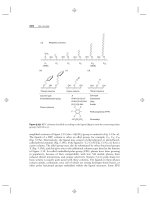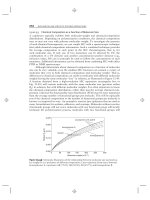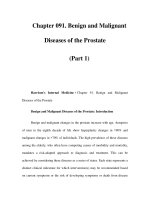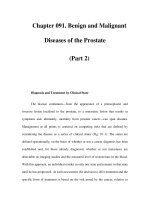Chapter 113. Introduction to Infectious Diseases: Host–Pathogen Interactions (Part 1) docx
Bạn đang xem bản rút gọn của tài liệu. Xem và tải ngay bản đầy đủ của tài liệu tại đây (37.97 KB, 5 trang )
Chapter 113. Introduction to Infectious Diseases:
Host–Pathogen Interactions
(Part 1)
Harrison's Internal Medicine > Chapter 113. Introduction to Infectious
Diseases: Host–Pathogen Interactions
Host–Pathogen Interactions: Introduction
Despite decades of dramatic progress in their treatment and prevention,
infectious diseases remain a major cause of death and debility and are responsible
for worsening the living conditions of many millions of people around the world.
Infections frequently challenge the physician's diagnostic skill and must be
considered in the differential diagnoses of syndromes affecting every organ
system.
Changing Epidemiology of Infectious Diseases
With the advent of antimicrobial agents, some medical leaders believed that
infectious diseases would soon be eliminated and become of historic interest only.
Indeed, the hundreds of chemotherapeutic agents developed since World War II,
most of which are potent and safe, include drugs effective not only against bacteria
but also against viruses, fungi, and parasites. Nevertheless, we now realize that as
we developed antimicrobial agents, microbes developed the ability to elude our
best weapons and to counterattack with new survival strategies. Antibiotic
resistance occurs at an alarming rate among all classes of mammalian pathogens.
Pneumococci resistant to penicillin and enterococci resistant to vancomycin have
become commonplace. Even Staphylococcus aureus strains resistant to
vancomycin have appeared. Such pathogens present real clinical problems in
managing infections that were easily treatable just a few years ago. Diseases once
thought to have been nearly eradicated from the developed world—tuberculosis,
cholera, and rheumatic fever, for example—have rebounded with renewed
ferocity. Newly discovered and emerging infectious agents appear to have been
brought into contact with humans by changes in the environment and by
movements of human and animal populations. An example of the propensity for
pathogens to escape from their usual niche is the alarming 1999 outbreak in New
York of encephalitis due to West Nile virus, which had never previously been
isolated in the Americas. In 2003, severe acute respiratory syndrome (SARS) was
first recognized. This emerging clinical entity is caused by a novel coronavirus
that may have jumped from an animal niche to become a significant human
pathogen. By 2006, H5N1 avian influenza, having spread rapidly through poultry
farms in Asia and having caused deaths in exposed humans, had reached Europe
and Africa, heightening fears of a new influenza pandemic.
Many infectious agents have been discovered only in recent decades (Fig.
113-1). Ebola virus, human metapneumovirus, Anaplasma phagocytophila (the
agent of human granulocytotropic ehrlichiosis), and retroviruses such as HIV
humble us despite our deepening understanding of pathogenesis at the most basic
molecular level. Even in developed countries, infectious diseases have made a
resurgence. Between 1980 and 1996, mortality from infectious diseases in the
United States increased by 64% to levels not seen since the 1940s.
Figure 113-1
Map of the world showing examples of geographic locales where
infectious diseases were noted to have emerged or resurged.
(Adapted from
Addressing Emerging Infectious Disease Threats: A Prevention Strategy for the
United States,
Department of Health and Human Services, Centers for Disease
Control and Prevention, 1994.)
The role of infectious agents in the etiology of diseases once believed to be
noninfectious is increasingly recognized. For example, it is now widely accepted
that Helicobacter pylori is the causative agent of peptic ulcer disease and perhaps
of gastric malignancy. Human papillomavirus is likely to be the most important
cause of invasive cervical cancer. Human herpesvirus type 8 is believed to be the
cause of most cases of Kaposi's sarcoma. Epstein-Barr virus is a cause of certain
lymphomas and may play a role in the genesis of Hodgkin's disease. The
possibility certainly exists that other diseases of unknown cause, such as
rheumatoid arthritis, sarcoidosis, or inflammatory bowel disease, have infectious
etiologies. There is even evidence that atherosclerosis may have an infectious
component. In contrast, there are data to suggest that decreased exposures to
pathogens in childhood may be contributing to an increase in the observed rates of
allergic diseases.
Medical advances against infectious diseases have been hindered by
changes in patient populations. Immunocompromised hosts now constitute a
significant proportion of the seriously infected population. Physicians
immunosuppress their patients to prevent the rejection of transplants and to treat
neoplastic and inflammatory diseases. Some infections, most notably that caused
by HIV, immunocompromise the host in and of themselves. Lesser degrees of
immunosuppression are associated with other infections, such as influenza and
syphilis. Infectious agents that coexist peacefully with immunocompetent hosts
wreak havoc in those who lack a complete immune system. AIDS has brought to
prominence once-obscure organisms such as Pneumocystis, Cryptosporidium
parvum, and Mycobacterium avium.









